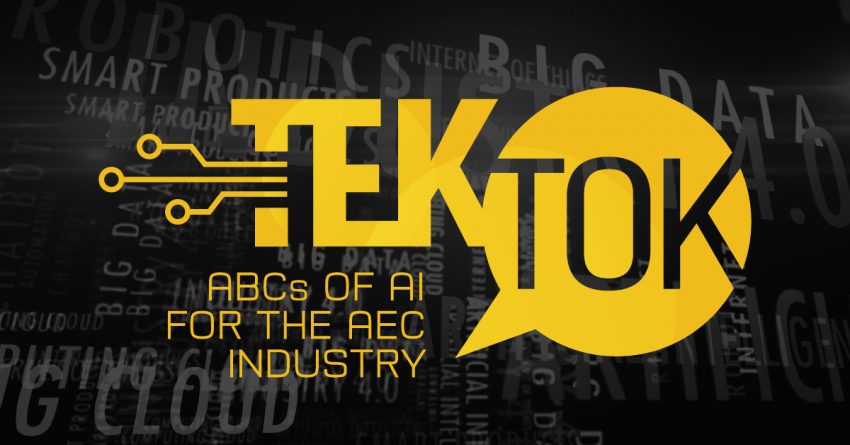The ABCs of AI for the AEC Industry: A Comprehensive Guide for AEC Industry Professionals
In the realm of marketing, artificial intelligence (AI) can play a pivotal role, significantly impacting various tasks and operations. By employing AI tools, marketers may not only enhance their efficiency but also gain the freedom to focus on refining their campaigns. Delving into the AI glossary provided below offers invaluable insights into the functioning of these tools.
A
Algorithm: A mathematical formula representing relationships between variables, utilized in machine learning models to make predictions based on analyzed data. Social media platforms, for instance, employ algorithms to predict and display content based on users’ past interactions.
Artificial Intelligence: An area of computer science where machines perform tasks that require human-like intelligence, including learning, reasoning, and problem-solving. AI enables systems to understand, interpret, and respond to information, mimicking human cognitive functions.
Artificial General Intelligence (AGI): The theoretical second stage of AI where systems possess intelligence comparable to human capabilities, allowing adaptation to new situations and abstract reasoning. Presently, the AI field is in the initial stage, and AGI remains a theoretical concept.
AI Analytics: Utilizing machine learning to process vast datasets and identify patterns, trends, and relationships without human intervention. Businesses leverage AI analytics to make data-driven decisions, enhancing competitiveness in the market.
AI Assistant: A chatbot or virtual assistant employing artificial intelligence to comprehend and respond to human queries, automate tasks, and enhance efficiency. AI assistants streamline interactions, providing immediate responses and saving time.
AI Bias: The phenomenon where machine learning systems reflect biases present in their training data, leading to biased outcomes. Addressing AI bias is crucial to avoid perpetuating harmful stereotypes and ensuring fair and ethical AI use.
AI Chatbot: A program utilizing machine learning and natural language processing to engage in human-like conversations. AI chatbots are widely used on websites, apps, and social media platforms to interact with customers and provide support.
AI Ethics: The study of ethical considerations associated with AI technology, emphasizing the responsible and harmless use of AI systems. Ethical AI deployment is essential to maintain user trust and prevent adverse consequences.
Anthropomorphize: The tendency to attribute human qualities, emotions, or intentions to AI systems due to their human-like abilities. However, experts emphasize that AI lacks emotions and consciousness, merely performing tasks as programmed.
Augmented Reality (AR): The integration of virtual elements, such as images or information, into the real-world environment, enhancing users’ perception and interaction with their surroundings. AR applications, like Snapchat filters, provide immersive experiences by overlaying virtual objects on real scenes.
Autonomous Machine: A machine capable of learning, reasoning, and making decisions without human intervention, using available data to perform tasks. Self-driving cars are prominent examples of autonomous machines, relying on AI algorithms for navigation and decision-making.
Auto-Complete: An AI feature that analyzes user input, whether text or voice, and suggests subsequent words or phrases based on historical data patterns and contextual information. Auto-complete enhances user experience by predicting and speeding up text input.
Auto Classification: The process of categorizing and tagging data into specific predefined categories, simplifying data organization, management, and retrieval. AI-powered auto classification systems automatically classify data, improving efficiency and accuracy.
B
Bard: Google’s conversational AI, utilizing the LaMDA language model for dialogue applications. Bard can extract information from the internet and engage in dynamic conversations.
Bayesian Network: A probabilistic model estimating the likelihood of events occurring. AI assists in creating Bayesian networks by rapidly evaluating data.
BERT: Google’s deep learning model, designed for natural language processing tasks like answering questions and analyzing sentiment. BERT comprehends the context of words in search queries, enhancing search accuracy.
Bing Search: Microsoft’s machine learning search tool using neural networks to understand user inputs and deliver relevant results. It also generates new text-based content and images using AI algorithms.
Bots: Text-based programs, often known as chatbots, automating tasks and providing information. Bots can range from simple rule-based systems to complex AI-driven applications.
C
Chatbot: A conversational AI simulating human interactions online, addressing common questions and directing users to appropriate resources. Chatbots are widely used in customer support and service industries.
ChatGPT: A conversational AI model based on the GPT (Generative Pre-trained Transformer) architecture. ChatGPT understands text prompts and responds with human-like interactions, making it valuable for various applications.
Cognitive Science: The interdisciplinary study of the mind and its processes. AI applications draw from cognitive science, utilizing neural networks and other cognitive models to replicate human-like intelligence.
Composite AI: Integrating different AI technologies to solve complex problems and handle multifaceted tasks. Composite AI combines various techniques to address challenges requiring diverse AI capabilities.
Computer Vision: Deep learning models analyzing and interpreting visual information from images and videos. Computer vision applications include image recognition, object detection, and facial recognition.
Conversational AI: Technology replicating human conversation styles, employing natural language processing (NLP) and natural language generation (NLG). Conversational AI systems understand context and respond accurately in human-like conversations.
D
Data Mining: The process of discovering patterns, relationships, and trends within large datasets. Machine learning algorithms accelerate data mining, enabling efficient analysis and extraction of valuable insights.
Deep Learning: A subset of machine learning involving neural networks with multiple layers. Deep learning algorithms learn from data to create complex models, making them suitable for tasks like image and speech recognition.
DALL-E: OpenAI’s generative model capable of creating images from detailed natural language prompts. DALL-E uses advanced algorithms to generate diverse and creative visual content based on textual descriptions.
E
Emergent Behavior: When AI systems exhibit behaviors or skills not explicitly programmed, indicating a capacity for learning and adaptation.
Entity Annotation: A natural language processing technique classifying data into predefined categories. Entity annotation makes data analysis and organization more accessible, enhancing comprehension and decision-making.
Expert Systems: AI applications replicating human experts’ decision-making abilities in specific domains. Expert systems utilize knowledge bases and algorithms to provide expert-level advice and solutions.
Explainable AI (XAI): AI systems designed to provide explanations for their decisions and predictions. XAI enhances transparency and trust, allowing users to understand the reasoning behind AI-generated outcomes.
F
Feature Engineering: The process of selecting relevant features from raw data to guide machine learning models during training. Effective feature engineering enhances model accuracy and performance.
Feature Extraction: Breaking down input data into specific features for classification and understanding. In image recognition, features might represent specific elements, aiding in predicting the content of the entire image.
G
Generative AI: AI models processing prompts and generating outputs, such as text, images, audio, and video, based on learned patterns. Generative AI relies on intricate algorithms to create diverse and contextually relevant content.
General Intelligence: The theoretical second stage of AI, where systems possess abstract thinking and problem-solving abilities comparable to human intelligence. General intelligence encompasses a broad spectrum of cognitive skills.
GPT: Generative Pre-trained Transformer, an OpenAI language model trained on extensive datasets. GPT understands natural language inputs, facilitating human-like conversations, content generation, and answering questions.
H
Hallucination: When AI produces factually incorrect outputs or information, deviating from accurate and reliable results.
I
Image Recognition: A machine learning process identifying objects, people, or places in images and videos. Image recognition applications, like Google Lens, utilize algorithms to analyze visual data accurately.
L
Large Language Model (LLM): Language models trained on extensive historical data to complete specific tasks. GPT and LamDA are examples of large language models, enabling sophisticated natural language interactions.
Language Model for Dialogue Applications (LamDA): Google’s large language model designed for realistic conversations and content generation. LamDA understands human inputs, providing accurate responses and creating new content.
Limited Memory AI: AI systems capable of performing tasks based on a limited amount of stored data. These systems lack the ability to extend their capabilities beyond stored information, making them suitable for specific applications.
M
Machine Learning: A subset of AI where machines use data and algorithms to make predictions, decisions, and complete tasks. Machine learning systems improve accuracy and performance over time through continuous learning.
Midjourney: A generative AI model creating images from natural language prompts. Midjourney employs sophisticated algorithms to generate visual content based on textual descriptions.
N
Narrow AI: AI systems designed for specific tasks and lacking adaptability beyond their predefined functions. Most AI applications fall under narrow AI, tailored for specific industries and applications.
Natural Language Processing (NLP): Machines’ ability to understand and interpret spoken and written language, enabling conversational experiences. NLP applications range from spell checkers to advanced language models.
Natural Language Generation (NLG): AI models processing language and generating responses or content based on contextual understanding. NLG systems craft human-like responses, enhancing communication and content creation.
Natural Language Query (NLQ): A written input resembling spoken language, devoid of special characters or syntax, enabling accurate interpretation by AI systems.
Neural Networks: Computerized replicas of the human brain's neural network structure, allowing systems to develop knowledge and predictions. Neural networks underpin various AI applications, enhancing their learning capabilities.
O
OpenAI: An artificial intelligence research laboratory responsible for creating advanced AI tools, including GPT and DALL-E.
P
Pattern Recognition: AI systems’ ability to identify patterns in data using algorithms developed during training. Pattern recognition enhances applications like image and speech recognition.
Predictive Analytics: AI applications utilizing algorithms to predict future occurrences based on patterns in historical data. Predictive analytics informs decision-making processes by anticipating future trends and events.
Prompts: Natural language inputs given to AI models, including questions, tasks, or content descriptions. Prompts instruct models to generate specific responses or create targeted content.
Prompt Engineering: Identifying precise words and phrases in prompts to align generative systems with users’ intent. Effective prompt engineering ensures AI produces desired outputs.
R
Reactive Machines: AI systems completing specific tasks without memory or contextual understanding. Reactive machines, like rule-based chatbots, lack awareness of past interactions or external context.
Reinforcement Learning: A machine learning process where systems learn through trial and error, adjusting actions based on feedback and rewards. Reinforcement learning enables autonomous decision-making and skill refinement.
Responsible AI: The ethical deployment of AI to avoid biases and stereotypes, ensuring technology benefits society. Responsible AI practices prioritize fairness, accountability, and transparency.
Robotics: Designing robots capable of autonomous tasks using programmed AI algorithms. Robotics merges AI with engineering, enabling machines to perform diverse functions.
S
Self-aware AI: The advanced stage of AI development where machines possess self-awareness and understand human emotions, needs, and beliefs. Self-aware AI remains a theoretical concept, pushing the boundaries of AI capabilities.
Semantic Analysis: AI systems extracting meaning from information inputs, accounting for complex factors like cultural context. Semantic analysis enhances natural language understanding and interpretation.
Sentiment Analysis: The process of identifying emotional signals in text to predict overall sentiment. Sentiment analysis informs businesses about public perception and emotional responses to products or services.
Sentient AI: AI systems exhibiting emotions and perceptions at a human level, implying emotional intelligence and self-awareness. Presently, sentient AI remains theoretical, representing the pinnacle of AI advancement.
Structured Data: Well-organized data easily comprehensible to machine learning algorithms. Structured data enhances AI accuracy and efficiency, enabling precise analysis and decision-making.
Supervised Learning: A machine learning approach where humans oversee the learning process, providing specific instructions and expected outcomes. Supervised learning refines AI models and ensures desired performance.
T
Theory of Mind AI: An advanced class of AI technology capable of understanding human mental states and using that knowledge for interactive and empathetic responses. Theory of mind AI enhances human-AI interactions.
Token: A single unit of data used by language models to understand input and make predictions. Tokens can represent individual words, characters, subwords, or specific features within visual data.
Training Data: The data provided to machines for learning and improving their performance in future tasks. Training data shapes AI models, enabling them to acquire knowledge and skills.
Transfer Learning: A machine learning technique using pre-trained models as starting points for new tasks. Transfer learning accelerates learning processes and enhances model adaptation.
Turing Test: An evaluation method invented by Alan Turing to determine if a machine's intelligence matches human performance. Originally called the imitation game, the Turing Test assesses AI capabilities based on indistinguishable human-like interactions.
Unsupervised Learning: A machine learning approach where systems identify patterns and draw conclusions from data without human intervention. Unsupervised learning allows AI to discover insights independently.
V
Virtual Reality (VR): Software immersing users in interactive three-dimensional virtual environments using sensory devices. VR applications provide immersive experiences, enhancing user engagement and interaction.
W
Weak AI: Also known as Narrow AI, it refers to AI systems designed for specific tasks without adaptability beyond their intended functions. Weak AI systems lack general intelligence and specialize in predefined applications.
This comprehensive glossary equips AEC industry professionals with essential knowledge, empowering them to leverage AI effectively in marketing endeavors. By understanding these terms, marketers can understand AI technologies better and, if desired, use them to optimize strategies, enhance customer experiences, and stay ahead in the ever-evolving digital landscape.






